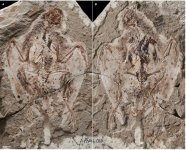Fred Ruhe
Well-known member

Di Liu, L.M. Chiappe, Yuguang Zhang, F.J. Serrano & Qingjin Meng, 2018
Soft tissue preservation in two new enantiornithine specimens (Aves) from the Lower Cretaceous Huajiying Formation of Hebei Province, China
Cretaceous Research. in press. doi:10.1016/j.cretres.2018.10.017
Abstract: https://www.sciencedirect.com/science/article/pii/S0195667118301174?via=ihub
We describe two nearly complete enantiornithine skeletons from the Lower Cretaceous Huajiying Formation (ca. 130.7 Ma) of northern Hebei province, China. Many morphological features indicate that these specimens represent a new taxon, here named Orienantius ritteri gen. et sp.. nov. The new fossils preserve their plumage as well as rare information about their soft tissues, including the wing’s patagia. Multivariate analyses of their skeleton and flight feathers provide insight into the aerodynamic performance of these early enantiornithines, suggesting that these birds had evolved highly maneuverable, intermittent flap-gliding flight. Additionally, the presence in this new taxon of traits characteristic of younger enantiornithines and the broad phylogenetic spread of the clade during the Huajiying Formation corroborates previous claims that a significant episode of taxonomic differentiation took place prior to the earliest known phases of this clade’s evolutionary history.
Enjoy,
Fred
Soft tissue preservation in two new enantiornithine specimens (Aves) from the Lower Cretaceous Huajiying Formation of Hebei Province, China
Cretaceous Research. in press. doi:10.1016/j.cretres.2018.10.017
Abstract: https://www.sciencedirect.com/science/article/pii/S0195667118301174?via=ihub
We describe two nearly complete enantiornithine skeletons from the Lower Cretaceous Huajiying Formation (ca. 130.7 Ma) of northern Hebei province, China. Many morphological features indicate that these specimens represent a new taxon, here named Orienantius ritteri gen. et sp.. nov. The new fossils preserve their plumage as well as rare information about their soft tissues, including the wing’s patagia. Multivariate analyses of their skeleton and flight feathers provide insight into the aerodynamic performance of these early enantiornithines, suggesting that these birds had evolved highly maneuverable, intermittent flap-gliding flight. Additionally, the presence in this new taxon of traits characteristic of younger enantiornithines and the broad phylogenetic spread of the clade during the Huajiying Formation corroborates previous claims that a significant episode of taxonomic differentiation took place prior to the earliest known phases of this clade’s evolutionary history.
Enjoy,
Fred




